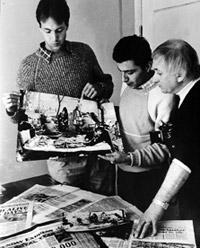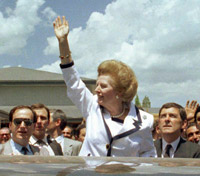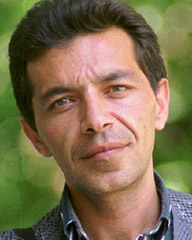The earthquake of 1988 in Armenia echoed throughout the world. Millions of people wanted to help the victims of this terrible earthquake by lending a hand to the people that had been left homeless and had nowhere to stay during the cold winter. The photographs taken during those dark days were the silent witnesses, which could have said more than the most heartfelt words. In a matter of minutes, the faces of the relatives, the people of Gyumri and Spitak who had lost their homes expressed extreme pain and desperateness- so much that there was no need to express that through words. The photos shocked the world. The local photographers taking pictures during the first days of the earthquake knew that they were creating the chronology of the disaster. Photographer for the “Photolur” agency Mkhitar Khachatryan says: “I knew I had to work no matter how I felt. I could not stop the tears from falling down my face, but as soon as I reached Leninakan, I turned into a robot and got to work. My job was to take photos.” There were many photos taken during the winter of 1988, however, this story is about one photo and one destiny. We refer to 23 year old textile factory worker Zhenya’s son Vitya.

Both live in Leninakan. “When I was taking photos, I didn’t know the name of that child. He was one of the thousands of children,” says photographer M. Khachatryan. Vitias family found itself in the middle of the streets and was forced to spend some nights under the open sky, Vitia slept on a folded bed covered by some blankets. It was cold outside, 20 degrees. This black eyed kid is not Armenian, however, he has become the symbol of the earthquake.
 When this photo was shown on the front page of “Sunday Express”, thousands of Englishmen wanted to know who the child was and how his life turned out. This boy’s photo has been shown in the monthly for nearly one month and has helped persuade many to make donations for the innocent victims. The readers of “Sunday Express” that read the article were demanding information about the child from us. Photographer for the monthly Tony Weaver and journalist Andrew Alderson came to Armenia and met with the man who had photographed the boy-Mkhitar Khachatryan. “They wanted to find that boy. We went to Gyumri. I remembered where I had taken pictures of the family, but I didn’t know who they were,” says Khachatryan. After some investigation, Khachatryan and the Englishmen found out that that boy was Vitia Kirjak whose mother was Moldavian and his father was probably Georgian. They also found out that the family currently lives in one of the health centers. After finding the boy, the “Sunday Express” reporters gave him presents and took photos. Upon returning to London, they decided to print the photos and place them in the book/album dedicated to the earthquake. Tony Weaver’s photos were also added to the Armenian photographer’s works and the work entitled “Armenia-psychology of faith” was published in the beginning of 1989. This book depicted the earthquake that took the lives of 25 thousand people and left half a million homeless through the most international language-photographs. As for the non-Armenian Vitia, he became the symbol of hope for the future of Armenia. Photographer M. Khachatryan was a little confused. He also felt a little offended when he found out that the boy who was in the center of attention of so many Englishmen was not Armenian. However, disasters neither care about nationality nor age. How long has the boy lived in Leninakan and where is the 20 year old young Vitia?
When this photo was shown on the front page of “Sunday Express”, thousands of Englishmen wanted to know who the child was and how his life turned out. This boy’s photo has been shown in the monthly for nearly one month and has helped persuade many to make donations for the innocent victims. The readers of “Sunday Express” that read the article were demanding information about the child from us. Photographer for the monthly Tony Weaver and journalist Andrew Alderson came to Armenia and met with the man who had photographed the boy-Mkhitar Khachatryan. “They wanted to find that boy. We went to Gyumri. I remembered where I had taken pictures of the family, but I didn’t know who they were,” says Khachatryan. After some investigation, Khachatryan and the Englishmen found out that that boy was Vitia Kirjak whose mother was Moldavian and his father was probably Georgian. They also found out that the family currently lives in one of the health centers. After finding the boy, the “Sunday Express” reporters gave him presents and took photos. Upon returning to London, they decided to print the photos and place them in the book/album dedicated to the earthquake. Tony Weaver’s photos were also added to the Armenian photographer’s works and the work entitled “Armenia-psychology of faith” was published in the beginning of 1989. This book depicted the earthquake that took the lives of 25 thousand people and left half a million homeless through the most international language-photographs. As for the non-Armenian Vitia, he became the symbol of hope for the future of Armenia. Photographer M. Khachatryan was a little confused. He also felt a little offended when he found out that the boy who was in the center of attention of so many Englishmen was not Armenian. However, disasters neither care about nationality nor age. How long has the boy lived in Leninakan and where is the 20 year old young Vitia?
 Thanks to the one month fund organized by “Sunday Express” in 1989, nearly 300,000 funt sterling was collected. A large part of the money was used to construct the school in Gyumri. “We photographers also have a large investment for the school construction. That investment can be looked at directly or indirectly,” says M. Khachatryan. That one photo was instilled in the minds of the Englishmen and reminded us about generosity. They helped many children with the thought of that one boy in their minds. Prime Minister of Great Britain Margaret Thatcher was present during the opening of the English school several years after the earthquake. She didn’t visit Yerevan, but rather she immediately came to Gyumri and ended the “Sunday Express” project which had started thanks to that one picture.
Thanks to the one month fund organized by “Sunday Express” in 1989, nearly 300,000 funt sterling was collected. A large part of the money was used to construct the school in Gyumri. “We photographers also have a large investment for the school construction. That investment can be looked at directly or indirectly,” says M. Khachatryan. That one photo was instilled in the minds of the Englishmen and reminded us about generosity. They helped many children with the thought of that one boy in their minds. Prime Minister of Great Britain Margaret Thatcher was present during the opening of the English school several years after the earthquake. She didn’t visit Yerevan, but rather she immediately came to Gyumri and ended the “Sunday Express” project which had started thanks to that one picture.

